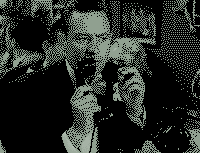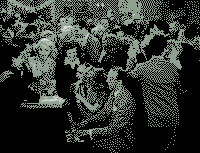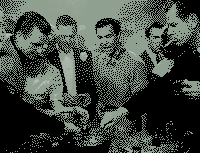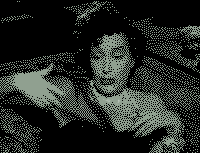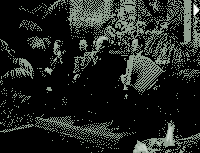April 30, 2008
Cops Kill
Last Friday, three New York City police officers were acquitted for the killing of
23-year old Sean Bell, early in the morning on what was to be his wedding day, in
November of 2005. Bell’s 50-bullet murder sparked outrage in a city that is no
stranger to police brutality; the list of police killings of unarmed black men over
the years is long and familiar.
People like to treat police shootings as “tragic” isolated incidents, but the ugly
truth is that police officers inflict violence on black communities on a regular
basis. And they get away with it, time and time again. “When cops go on trial for
overuse of deadly force, their victims are generally young blacks and Latinos,” writes
one commentator. “The attorneys that defend them are top gun defense attorneys and
have had much experience defending police officers accused of misconduct. Police
unions pay them and they spare no expense in their defense. The cops rarely serve any
pre-trial jail time, and are released on ridiculously low bail.”
Bell, meanwhile, was handcuffed while mortally injured. Is this really what we call
“justice for all”?
April 29, 2008
Man charged over Pacific money laundering scheme
A 58-year-old Australian man is due to be extradited to from Western Australia to the state of New South Wales after police broke up an international money laundering scheme.
The alleged scheme operated in Australia, Vanuatu and New Zealand and involved around $US87 million.
Robert Agius, who had been living in Vanuatu, has been charged with fraud and money laundering offences relating to the scheme, which was exposed by a police task force targeting tax evasion.
Australian federal police officer, Warren Gray, says around 400 people put money into a scheme, allegedly operated by Agius, in which millions of dollars was moved into offshore bank accounts to avoid tax
Agius was arrested on Monday in the western Australian city of Perth, and appeared briefly in court where he was ordered to be returned to Sydney to face trial.
He faces a maximum penalty of 25 years in prison if convicted.
April 28, 2008
Higher Education on Nicaragua’s Multicultural Atlantic Coast
http://209.200.101.189/publications/csq/csq-article.cfm?id=1718
The University of the Autonomous Regions of the Caribbean Coast of Nicaragua (URACCAN) is a pluri-ethnic university located in the Caribbean region of Nicaragua. The university provides higher education to some of the country’s most marginalized peoples, including the indigenous Miskitu, Mayanga, and Rama, and the Afro-Caribbean Creole and Garífuna, all of whom live in the eastern half of the country. While comprising only four percent of Nicaragua’s total population, these coastal groups represent most of the country’s cultural and linguistic diversity.
The idea for creating the university came about during an organizational meeting of young Caribbean Coast leaders in 1978, attended by most of the region’s college graduates. A major topic of discussion was the idealistic dream of a regional university. In the 1970s, most costeños, or Caribbean coastal peoples, had little access to higher education because their only option was to travel far to the west to the universities of Hispanic Nicaragua.
It was not until after the war years of the 1980s that the dream could be realized. URACCAN was founded in the early 1990s, and in 1995 was recognized by the Nicaraguan National Council of Universities (CNU), the council that regulates higher education. A year later, the university began receiving government funding. The university continues, however, to compete with older, more established universities in Hispanic Nicaragua to obtain a fair share of national funding. The university is located in a poor region where tuition is extremely low (U.S. $12 per semester). Even so, a large share of the university budget is devoted to student scholarships. Outside funding sources are important to the university’s success. For example, a National Conference of URACCAN Supporters and Support Groups met in Chicago in the 1990s to raise money for the university, but most of the university’s external funding comes from European universities and organizations.
Serving a Diverse Population
URACCAN is designed to serve all of costeños and to emphasize the region’s multicultural heritage. The mestizo population of 117,143 is growing rapidly through immigration from the western, Hispanic part of Nicaragua. It threatens to overwhelm the other groups, thus underlining the importance of URACCAN’s focus on diversity.
The major languages spoken at URACCAN are Spanish, Creole English, Miskitu, and Mayanga. Signs on the university walls are written in all four languages. Miskitu has been a written language since Moravian missionaries, who arrived on the coast in 1849, recorded it in writing and translated the Bible and other religious documents (Helms 1971). The missionaries also trained local lay preachers, or sasmalkra, who preached from texts in their own language. Today various competing groups, including the Church of God, the Catholic Church, and the Seventh Day Adventists, all work on the coast. Nevertheless, in many ways the Moravian Church remains the central religious authority in the region. Moravians have recently established their own university, the Bluefield Indian and Caribbean University (BICU), which now occupies the old Moravian hospital building in Bilwi. BICU is privately funded and thus provides a second option for higher education. Costeño leaders hope that the presence of URACCAN and BICU will encourage the most capable young people to earn degrees on the coast, and remain afterward to contribute their talents to the region’s growth.
URACCAN opened its first three branches in Bilwi, Bluefields, and Siuna, and now has extension courses in La Rosita, Bonanza, Waspam, Pearl Lagoon, Orinoco, and Nueva Guinea. Today, about 2,500 students attend the university, with 200 professors teaching courses. Continuing education and technical training courses are offered, as well as courses leading to bachelor’s degrees in sociology, agro-forestry, business administration, and education.
The university also has four research institutes—the Institute for Linguistic Research and Cultural Recovery, the Natural Resource and Environment Institute, the Institute for Promotion and Study of Autonomy, and the Institute for Traditional Medicine and Community Development.
The Traditional Medicine Institute maintains a medicinal plant garden at Krabu Tingni, in a beautiful rainforest location midway between Bilwi and Waspam. A Miskitu medicinal healer is in charge of the gardens, to which other healers also have access. The resident healer demonstrates plant medicines to students and other visitors.
During his Fulbright grant from 1999 to 2000, Philip Dennis worked closely with the institute. In 1999, an outbreak of grisi siknis, a dramatic culture-bound syndrome, occurred at the Luxembourg Teachers College in Bilwi, causing a crisis in which many of the college students left after 10 young women were possessed by evil spirits. The institute hired a well-known traditional healer who treated the young women successfully with prayer and medicinal herbs, while Dennis and the healer’s husband served as assistants. Two physicians were also involved in the treatment, which constituted a remarkable example of collaboration between biomedical and traditional practitioners.
URACCAN relies on visiting professors to teach many courses. During the 1999-2000 academic year, Dennis taught an anthropology of health course in URACCAN’s first graduate program, an intercultural master’s degree in public health (MSPI). Thirty-eight graduate students participated in the course, of whom about two-thirds were physicians and nurses. Other participants included a nutritionist, a dentist, a psychologist, and a community development worker. Most of the graduate students were mestizos from western Nicaragua, but there were also a number of Creole and Miskitu health professionals. The master’s of public health degree (MPH) is an important credential for anyone involved in health matters in Central America, as it is in the United States. In Nicaragua, the traditional MPH degree is given by the National School of Public Health (CIES) in Managua. But URACCAN organized the intercultural MSPI degree for the Caribbean Coast, in recognition of the region’s multicultural nature and the particular health concerns it presents. The MSPI degree is accredited by the CIES, and coursework covers all the material in a traditional MPH program, plus cross-cultural material relevant to the coast. Dennis’ course was an important part of the MSPI’s multicultural perspective.
Most of the other courses in the new MSPI program were taught in intensive one- or two-week blocks by mestizo professors from CIES who flew to Bilwi to give lectures. Because Dennis planned to live in his research community, Awastara, to the north of Bilwi, he was able to teach his course over an 11-month period, holding classes one week each month. The MSPI students turned out to be hard-working and interested in the material, and responded enthusiastically to the fieldwork projects.
The university is developing a new master’s degree in socio-cultural anthropology in order to train Native anthropologists on the Atlantic Coast. Drawing from her extensive field experience among the Miskitu peoples of Honduras, Laura Hobson Herlihy will teach a graduate course on ethnographic field methods at URACAAN-Bilwi in spring 2004, also supported by a Fulbright grant. URACCAN’s first rector, Myrna Cunningham, said that the course will be part of the core curriculum of the new master’s program, which will be coordinated by Georg Grunberg and emphasize the region’s autonomy. Students will work with Herlihy both in the classroom and in the field, doing ethnographic research in local communities. Herlihy and Dennis both hope to keep the U.S.–URACCAN connection strong through future Fulbright exchanges.
The URACCAN was organized by and for local peoples, and tries to give voice to all the ethnic groups on the Coast. Large numbers of Miskitu students attend URACCAN-Kambla, and Creole students are prominent at URACCAN-Bluefields. However, there has been little Miskitu representation in the university administration. During his year at URACCAN, Dennis suggested that Miskitu intellectuals such as Ana Rosa Fagoth and Avelino Cox be invited to participate more in university activities, and that academic courses be offered using Miskitu as a language of instruction. In part, the limited participation of Miskitu scholars simply reflects the limited number of Miskitu people with university training. In addition, the Moravian Church-supported BICU may attract Miskitu people interested in faith-based education. Nevertheless, it seems ironic that the colonial languages, Spanish and English, continue to dominate, and that indigenous language and worldview remain underrepresented in university activities and administration. Indigenous peoples are lowest in the scale of interethnic relations on the coast, and to some extent this situation is paralleled in the university. It seems clear that to be successful as a multilingual, multicultural institution, URACCAN must invite more participation by leaders from all the region’s ethnic groups.
Miskitu people have a complex set of ideas about health and illness, and traditional healers provide a large share of the health care in the region. Historically, biomedical professionals from the United States and from the western, Hispanic region of Nicaragua have viewed local beliefs with skepticism, and have not taken traditional healers seriously. Given this context, some Creole administrators predicted the mestizo physicians in Dennis’ class would be narrow-minded and the most difficult group to work with. In reality, they asked the most perceptive questions and showed the most interest in the intercultural perspective presented. When Dennis invited traditional Miskitu healers to the class to explain Miskitu concepts of health and to demonstrate curing techniques, the mestizo physicians were the first to volunteer to help in the demonstration.
International Collaboration
Library holdings at URACCAN-Bilwi are modest indeed—one room of books. This lack of reading materials for students is a serious problem, and by necessity many classes use Xerox copies of articles or book chapters for reading assignments. For his anthropology of health course, Dennis brought textbooks from the United States, including a thick reader of medical anthropology articles in Spanish and the Spanish-language editions of Where There is No Doctor and Helping Health Workers Learn from the Hesperian Foundation. Dennis hoped that these texts would serve as useful future reference sources for the health care professionals taking the course.
Dennis also organized a large book drive at Texas Tech University, during which many colleagues in different fields donated basic texts and other books for the URACCAN library. Of course, most of these books were in English and may be of limited use to URACCAN students and faculty. But where books are available, one can hope they will eventually be of use to an aspiring scholar. Unfortunately, due to changes in U.S. Postal Service regulations, the last carton of books sent in 2003 cost about $75. At this price, it will be impossible to continue the book donation program.
Despite financial problems, URACCAN has been successful at forming national, regional, and international ties. Besides having a press office, a Web site, and a liaison office in Managua, the university has bilateral agreements with two Canadian universities, four U.S. universities, and three universities in Spain. Almost 30 URACCAN professors are pursuing advanced degrees in York, Canada, and Girona, Spain. One anthropologist colleague, Miguel González, former rector at URACCAN-Bluefields, is now completing his doctorate degree in political science at York University in Toronto.
The university also has ties with a vast array of non-governmental organizations, institutes, and foundations. Among them are Gesellschaft für Technische Zusammenarbelt of Germany, Centro Agronómico Tropical de Investigaciones y Enseñanza in Costa Rica; and the Rigoberta Menchú Foundation in Guatemala. These ties allow URACCAN to lead several important regional and continental initiatives, “especially regarding Indigenous, educational, health, and human rights networks,” reports the URUCCAN Update in 1998.
URACCAN and Autonomy
The Atlantic Coast region won constitutional autonomy in 1987 during the Sandinista revolutionary decade. The Nicaraguan government established two autonomous regions on the Caribbean Coast, the North Atlantic Autonomous Region (RAAN), and the South Atlantic Autonomous Region (RAAS). The RAAN and RAAS make up over 50 percent of Nicaragua’s territory. The RAAN regional government is located in Bilwi and the RAAS regional government is in Bluefields. URACCAN’s Bilwi-Kambla campus thus serves a large Miskitu population, and the Bluefields campus serves the Creole population.
URACCAN’s new vision of indigenous education is not only to provide life-long education to costeños, but, according to the URACCAN Update, “to help fortify the autonomy process on the Nicaraguan Caribbean Coast through training and professionalizing of human resources.” The university, for example, offers many outreach or short-term courses to improve the working populations’ technical skills. These courses have a community-based and participatory focus, and provide costeños with a way to contribute to their own self-empowerment. The goal is to no longer be dependent upon mestizos from western Nicaragua. Rather, through higher education, costeños hope to be able to control their own development process in the future.
Constitutional recognition was also given to minority languages in the autonomous regions. Since then, URACCAN has played a central role in developing the Intercultural Bilingual Education Program (PEBI) on the coast. Linguists from the Massachusetts Institute of Technology and from Europe worked with Terra Nuova, an Italian development organization, to develop new bilingual (Miskitu and Spanish) textbooks for grades one through four. These textbooks are now being used in a number of schools in the RAAN.
Unfortunately, the bilingual program has not been supported by conservative central governments in Managua in recent years. Teachers continue, however, to train at URACCAN.
The URACCAN main campus is in the town of Kambla, seven kilometers west of Bilwi. A breezy coastal city, Bilwi is the intellectual, economic, and political capital for the Miskitu people. Here, Miskitu culture is popular culture. One hears the Miskitu language spoken on the radio and television, as well as in discos, buses, and marketplaces. Due to its proximity to Bilwi, URACCAN’s main Kambla campus is strikingly dominated by Miskitu culture and language.
Transportation by bus is provided to Kambla-Bilwi students, along the red dirt road linking the campus and the city. Indeed, just getting to class is a challenge during the rainy season. The campus is remotely situated for a reason: it sits on land formerly used by the Sandinista army. The classrooms, administrative offices, and small library are in one-story buildings that formerly functioned as Sandinista military barracks. Pleasant and attractive, the campus is surrounded by pine trees with green grass and cement social spaces between buildings. The gym and auditorium buildings loom the largest on campus.
In 1998, Herlihy attended a conference for Central American indigenous people on URACCAN’s Kambla-Bilwi campus. The conference, “Central American Workshop on Territorial Rights and the Legalization of Indigenous Territories,” was sponsored by Native Lands, Centro Skoki, and URACCAN. Much of the workshop focused on the International Labor Organization’s convention 169, which deals specifically with indigenous peoples’rights. Indigenous representatives came from all the Central American countries, and from Peru and Mexico. A majority of the representatives and attendees were Miskitu, since the conference was held in their homeland. Miskitu participants in the meeting spoke first in their own language, and their statements were then translated into Spanish. The main topic of discussion among Miskitu participants was autonomy, or klauna, for the Atlantic Coast.
URACCAN’s concept of autonomy does not imply separatism. Rather, it emphasizes improving the quality of life for all costeños through education. Through inter-cultural higher education, the university aspires to build a better Atlantic Coast and a better Nicaragua. This university has so far been quite successful, especially given that the Atlantic Coast is a marginalized region in one of the poorest countries in Central America. Watching the crowds of students and faculty boarding the bus for Kambla, one cannot help but be infected by their spirit of enthusiasm and optimism. These young people see higher education as opening doors to the future.
Indigenous Peoples of Eastern Nicaragua and the Atlantic Coast
The 110,000 Miskitu constitute the largest indigenous population in Nicaragua. They live in rainforest and coastal-lagoon terrain from the Rio Coco border with Honduras to just south of the Pearl Lagoon area. This mixed group speak the Miskitu language, a member of the Misumalpan language family, and trace their ancestry to an Amerindian group that intermarried with African and European populations, starting in the 17th century (Helms 1971). While other Latin American indigenous groups experienced assimilation and culture loss due to the colonial encounter, the Miskitu have grown in population, expanded their territory, and developed a strong ethnic identity. Today, the Miskitu are the major indigenous group on the coast. They became internationally known for their struggle against the Sandinista government in the 1980s.
Mary W. Helms did ground-breaking ethnography among Miskitu people, and her ethnography of the community of Asang, on the Río Coco, has become a classic. Helms suggests that the success of the Miskitu is closely related to their relations with outsiders who have come to the coast. Indeed, the Miskitu have continually expanded their population and established their identity through their interactions with the British, North Americans, and other foreigners. The colonial Miskitu, called “Zambos-Mosquitos,” dominated other indigenous groups on the Miskitu Coast. Through their alliances with the British, they acquired firearms, which they used to build a successful economy based on raiding and trade. In the last 200 years, the Miskitu have been residents of a British Protectorate, evangelized by the Moravian missionaries, and employed by North American and other foreign companies. The companies extracted local resources including gold, bananas, sea turtles, and most recently, shrimp, conch, and lobsters. The interconnectedness of global and local social identities is not new to the Miskitu, who have participated in what Helms (1969) calls a “purchase society” since colonial times. The Nicaraguan Miskitu seem to have refashioned their social identities into new practices that have empowered them in a globalized world. The Miskitu response to global economic and geopolitical forces provides an interesting lesson in survival and adaptation.
The Mayanga (previously known as Sumu) occupied the largest land area in eastern Nicaragua before European contact, but their numbers and territory have been much reduced. The modern Mayanga peoples, with a population of 13,204, have three surviving linguistic groups: the Panamaka, the Twahka, and the Ulwa. These languages also belong to the larger Misumalpan family. Traditionally swidden farmers and hunters, the Mayanga recently have become involved in monetized economies as wage-earners. They continue to live along the upper reaches and headwaters of Nicaragua’s northeastern rivers, particularly in the large Bosawas Reserve. The Mayanga share similar cultural and linguistic traits with the Miskitu, to whom they are closely related. The indigenous Rama people lived on the Miskitu Coast before contact and spoke Voto, a Chibchan language of South American origin. The Rama, like the Mayanga, also fell victim to Miskitu expansion during the 17th and 18th centuries. Today, their reduced population of 1,023 is centered on Rama Cay, a small island in Bluefields Lagoon. The Rama people have all but lost their language, and now speak their own version of Creole English (Barrett 1992). Atlantic Coast Creoles are descendants of British colonists and African slaves who have lived on the coast since the 17th century. They speak Creole English and practice Protestantism, and their population center is in the cities of Bluefields and Puerto Cabezas (called Bilwi in Miskitu). During the colonial era, Creole society included free blacks who acquired higher status and prestige than the indigenous groups on the Miskitu Coast, mainly because they were perceived as being more Europeanized. After the British formally left the coast in 1787, the Creoles stayed behind and became the dominant ethnic group, eventually displacing the Miskitu in the socio-economic hierarchy of the Caribbean Coast (Gordon 1998). Today, the Creoles number 50,000.
The Garífuna trace their ancestry to Island Caribs on St. Vincent of the Lesser Antilles. Here, the Caribs inter-married with African slaves and were later deported to Honduras in 1797. The Garífuna people’s Afro-Caribbean culture and their Arawakian language, called Garífuna, thrive along the coast in Belize, Guatemala, and Honduras, but in Nicaragua are now represented by only two communities. Coming from Honduras in the late 1800s, the Garífuna settled on the western side of Pearl Lagoon and now have a population of 3,068 people. Their two villages are an enclave that remains cut off from the rest of the Garífuna culture area (Davidson 1979). Although the Nicaraguan Garífuna now speak Creole English, they still maintain strong beliefs in ancestor spirits and a distinct Garífuna identity (Barrett 1992). Some young Garífuna have embraced a racialized identity as Latin American Blacks and see themselves as part of the African American diaspora.
Ellice Islands
Tuvalu was also known as Ellice Islands. It is situated in the Pacific Ocean somewhere between Australia and Hawaii. It is the third least populated country in the world. Tuvalu consists of nine land masses which is circular shaped and is found in the central region of the Pacific Ocean.
Among these nine islands, three are bigger and six smaller in size. There are some 129 islets found here. The nine islands are Niutao, Funafuti, Nukufetau, Nanumaga, Niulakita, Nanumea, Nukulaelae, Nui andVaitupu. Here the soil is not suitable for agriculture and the water bodies are landlocked. Lagoons are very common at this place.
Tuvalu has a tropical climate. Precipitation is very much regular and the islands are full of water. There are some fishes and sea plants which are found in the oceans surrounding it. Coconut Palms and pandanus is found in the water bodies surrounding it. The Polynesian rat is the only native animal to be found in the island. The other animals are pigs, dogs and cats. Tourism is one of the major industries in the country and for the right reasons too. People from all over the world visit this beautiful country to see the beautiful beaches.
The beautiful beach at Funafuti attracts many visitors who come here to rejuvenate themselves by sun bathing on the shores. The Polynesian people on the island are very friendly and any tourist visiting the island will surely spend a day in the beautiful surroundings that the Polynesian ethnic people live in. The island is famous for the smallness of the land area and the vastness of the ocean. The island also has many lagoons and smaller island which add to the unique ambience of the island of Tuvalu.
The Funafuti conservation area spread over an area of 33 square kilometres is something that visitors should not miss at all. It includes beautiful reefs, channel and six uninhabited islets. All these attractions of the Funafuti conservation area attract tourists from all over the world. If you are looking for a piece of history then Tuvalu has that too. During the World War 2, the American forces built an airbase on the Northeastern side of Nanumea which is a major tourist attraction today. The drilling site of scientists on the island of Funafuti is another attraction. The site was created by scientists to prove Darwin’s theory of atolls. The Tuvalu Philatelic Bureau is another attraction that tourists do not want to miss out on while on a visit to this country. Stamps which depict various facets of the Tuvalu history are available with the Philatelic bureau.
If you are visiting Tuvalu, do not miss the traditional dance of the Polynesian ethnics. The national game of the country is te ano and taking part in one of the games is something that many tourists do.
Hundreds of fake passports seized in Thailand
Thai police arrested and charged a man from Bangladesh found in possession of hundreds of fake passports and visas, a senior police official said on Sunday.
Mohammed Karim, 56, was arrested in a rented house in Bangkok by police investigating a gang of foreign counterfeiters.
They found 90 real passports, 577 fake US and European passports, 680 counterfeit visas and 1,680 fake passport photo pages, mostly for American passports, said police Lieutenant Colonel Sophon Sarapat.
“Karim confessed and he was charged with conspiring to make counterfeit passports for sale, and making fake visas,” he said.
One Thai and one Myanmar citizen also alleged to be involved in the global counterfeiting ring escaped, Sophon added.
Karim could face a maximum of 20 years in jail if convicted.
Passport fraud is a common problem in Thailand. At the end of 2006, Thai and US police launched a joint sting operation which netted 500 fake US passports.
A Thai man and a Pakistani man were arrested on that occasion.
April 27, 2008
Food Sovereignity
The only surprising thing about the global food crisis to Jim Goodman is the notion that anyone finds it surprising. “So,” says the Wisconsin dairy farmer, “they finally figured out, after all these years of pushing globalization and genetically modified [GM] seeds, that instead of feeding the world we’ve created a food system that leaves more people hungry. If they’d listened to farmers instead of corporations, they would’ve known this was going to happen.” Goodman has traveled the world to speak, organize and rally with groups such as La Via Campesina, the global movement of peasant and farm organizations that has been warning for years that “solutions” promoted by agribusiness conglomerates were designed to maximize corporate profits, not help farmers or feed people. The food shortages, suddenly front-page news, are not new. Hundreds of millions of people were starving and malnourished last year; the only change is that as the scope of the crisis has grown, it has become more difficult to “manage” the hunger that a failed food system accepts rather than feeds.
We must rein in the global food giants who reap profits at the expense of the planet and the poor.
The current global food system, which was designed by US-based agribusiness conglomerates like Cargill, Monsanto and ADM and forced into place by the US government and its allies at the World Bank, the International Monetary Fund and the World Trade Organization, has planted the seeds of disaster by pressuring farmers here and abroad to produce cash crops for export and alternative fuels rather than grow healthy food for local consumption and regional stability. The only smart short-term response is to throw money at the problem. George W. Bush’s release of $200 million in emergency aid to the UN’s World Food Program was appropriate, but Washington must do more. Rising food prices may not be causing riots in the United States, but food banks here are struggling to meet demand as joblessness grows. Congress should answer Senator Sherrod Brown’s call to allocate $100 million more to domestic food programs and make sure, as Representative Jim McGovern urges, that an overdue farm bill expands programs for getting fresh food from local farms to local consumers.
Beyond humanitarian responses, the cure for what ails the global food system–and an unsteady US farm economy–is not more of the same globalization and genetic gimmickry. That way has left thirty-seven nations with food crises while global grain giant Cargill harvests an 86 percent rise in profits and Monsanto reaps record sales from its herbicides and seeds. For years, corporations have promised farmers that problems would be solved by trade deals and technology–especially GM seeds, which University of Kansas research now suggests reduce food production and the International Assessment of Agricultural Science and Technology for Development says won’t end global hunger. The “market,” at least as defined by agribusiness, isn’t working. We “have a herd of market traders, speculators and financial bandits who have turned wild and constructed a world of inequality and horror,” says Jean Ziegler, the UN’s right-to-food advocate. But try telling that to the Bush Administration or to World Bank president (and former White House trade rep) Robert Zoellick, who’s busy exploiting tragedy to promote trade liberalization. “If ever there is a time to cut distorting agricultural subsidies and open markets for food imports, it must be now,” says Zoellick. “Wait a second,” replies Dani Rodrik, a Harvard political economist who tracks trade policy. “Wouldn’t the removal of these distorting policies raise world prices in agriculture even further?” Yes. World Bank studies confirm that wheat and rice prices will rise if Zoellick gets his way.
Instead of listening to the White House or the World Bank, Congress should recognize–as a handful of visionary members like Ohio Representative Marcy Kaptur have–that current trends confirm the wisdom of the Institute for Agriculture and Trade Policy’s call for “an urgent rethink of the respective roles of markets and governments.” That’s far more useful than blaming Midwestern farmers for embracing inflated promises about the potential of ethanol–although we should re-examine whether aggressive US support for biofuels is not only distorting corn prices but harming livestock and dairy producers who can barely afford feed and fertilizer. Instead of telling farmers they’re wrong to seek the best prices for their crops, Congress should make sure that farmers can count on good prices for growing the food Americans need. It can do this by providing a strong safety net to survive weather and market disasters and a strategic grain reserve similar to the strategic petroleum reserve to guard against food-price inflation.
Congress should also embrace trade and development policies that help developing countries regulate markets with an eye to feeding the hungry rather than feeding corporate profits. This principle, known as “food sovereignty,” sees struggling farmers and hungry people and says, as the Oakland Institute’s Anuradha Mittal observes, that it is time to “stop worshiping the golden calf of the so-called free market and embrace, instead, the principle [that] every country and every people have a right to food that is affordable.” As Mittal says, “When the market deprives them of this, it is the market that has to give.”
